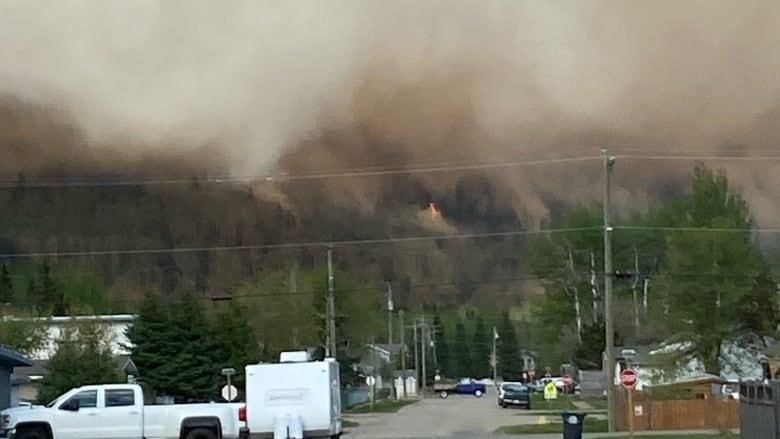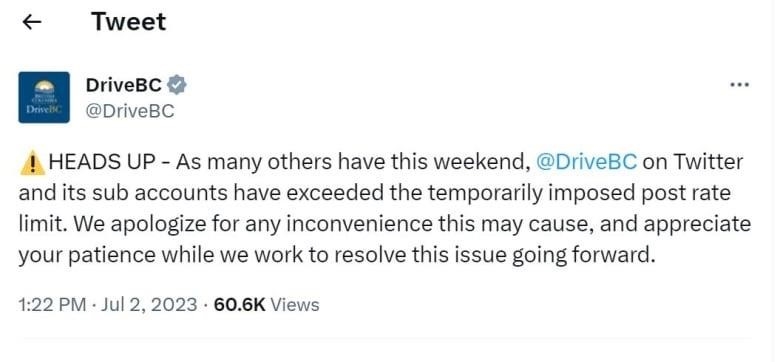
DriveBC says it sent too many tweets at once when it tried to send important wildfire road information
When Brandon Broderick was told to leave his home in Tumbler Ridge, British Columbia, last month, social media became an important way to find out what was going on.
He was able to go home on June 15, but he said that during the week he was away, he often checked Facebook to feel better.
The photographer told CBC News on Tuesday that they were following social media because that was how they knew what was going on in the area. “And we did find that lots of places used Facebook, like the B.C. Wildfire Service and the district.”
But people are worried about the use of social media during emergencies after B.C.’s Transportation Ministry was unable to post important information about routes and travel on Twitter last week during the province’s wildfire season.
As more people like Broderick in British Columbia prepare for evacuation orders and alerts because of the hundreds of fires in the province’s interior, many still look to social media for the latest important information, even though the government has been telling people to use official websites.
On July 2, a popular route advisory Twitter feed run by British Columbia’s Ministry of Transportation and Infrastructure suddenly stopped being able to post route updates to Twitter. This brought the problem to the forefront.

The Ministry of Transportation and Infrastructure tweeted on July 2 that “DriveBC on Twitter and its sub-accounts have reached the temporary limit on the number of posts per hour.”
Even though DriveBC was tweeting again within an hour, some emergency experts are worried about how well authorities will be able to talk to each other during a disaster.
Peter Chow-White, who is the director of the GENA Lab and a professor of communications at Simon Fraser University, said, “It’s crazy to have such a dramatic and immediate effect.” “There is a range of risks, from feeling anxious and confused to being cut off from the people in your life.
“But obviously, when there is a crisis, like a fire or an earthquake, it can be about people’s lives… It hasn’t gotten to the point where it’s dangerous yet, but it could.”
DriveBC said on Twitter that they were sorry for the trouble they were causing drivers. It had read or interacted with more tweets than it was allowed to under a new, but reportedly temporary, Twitter policy that limits accounts to a certain number of reads to stop data scraping. The account’s owner, Elon Musk, said it had reached the limit.
Other important B.C. government accounts, such as the B.C. Wildfire Service, B.C. Hydro, and the Emergency Preparedness Ministry, said they didn’t have the same problem.
Authorities in other places are also worried.
The U.S. National Weather Service’s account for storm updates also broke Twitter’s new rules and couldn’t post on July 4.In April, New York City’s transit authority said it would stop giving service updates on Twitter because “the platform’s reliability could no longer be guaranteed.”
“It’s harder to count on.
When asked by email about concerns about using Twitter for important and emergency communications, the company sent an auto-response with a poop emoji. This is something CEO Elon Musk announced in March for emails sent to Twitter’s media relations email account.
Broderick said he is worried about the sudden changes.
“Fires will affect a lot of routes in British Columbia,” he said. “So the fact that DriveBC can’t keep people up to date is not good.”
WATCH | A communications expert talks about how reliable social media can be in an emergency:
But because many people think that government social media accounts are always up-to-date, Ahmed Al-Rawi, a communications expert at Simon Fraser University, said that officials shouldn’t rely too much on private social media companies to share important information.
Still, governments can’t avoid social media if that’s where people go to get answers and news.
“It’s becoming more and more like a necessary evil these days,” Al-Rawi said. “So, on the one hand, we need social media, but it’s getting harder and harder to depend on it.”
He said that governments will have to think about where they post as more platforms appear for people who aren’t happy with the social media services that are already available. Al-Rawi says that information should be posted in as many places as possible so that it can reach as many people as possible.
Just a few weeks before Twitter’s changes, several social media giants and Google threatened to stop Canadian news articles from being shared on their platforms. This was in response to a controversial federal law that was supposed to protect Canadian journalism.
B.C. says the best way to get accurate and up-to-date alerts during a crisis is to use official apps and websites.
Broderick from Tumbler Ridge says that he sometimes sees false information and confusion on social media sites during wildfire season. He says that this is a good reminder to be wary of anything that doesn’t come from an official source or a reliable media outlet.
“Don’t put all of your eggs in the social media basket.”
